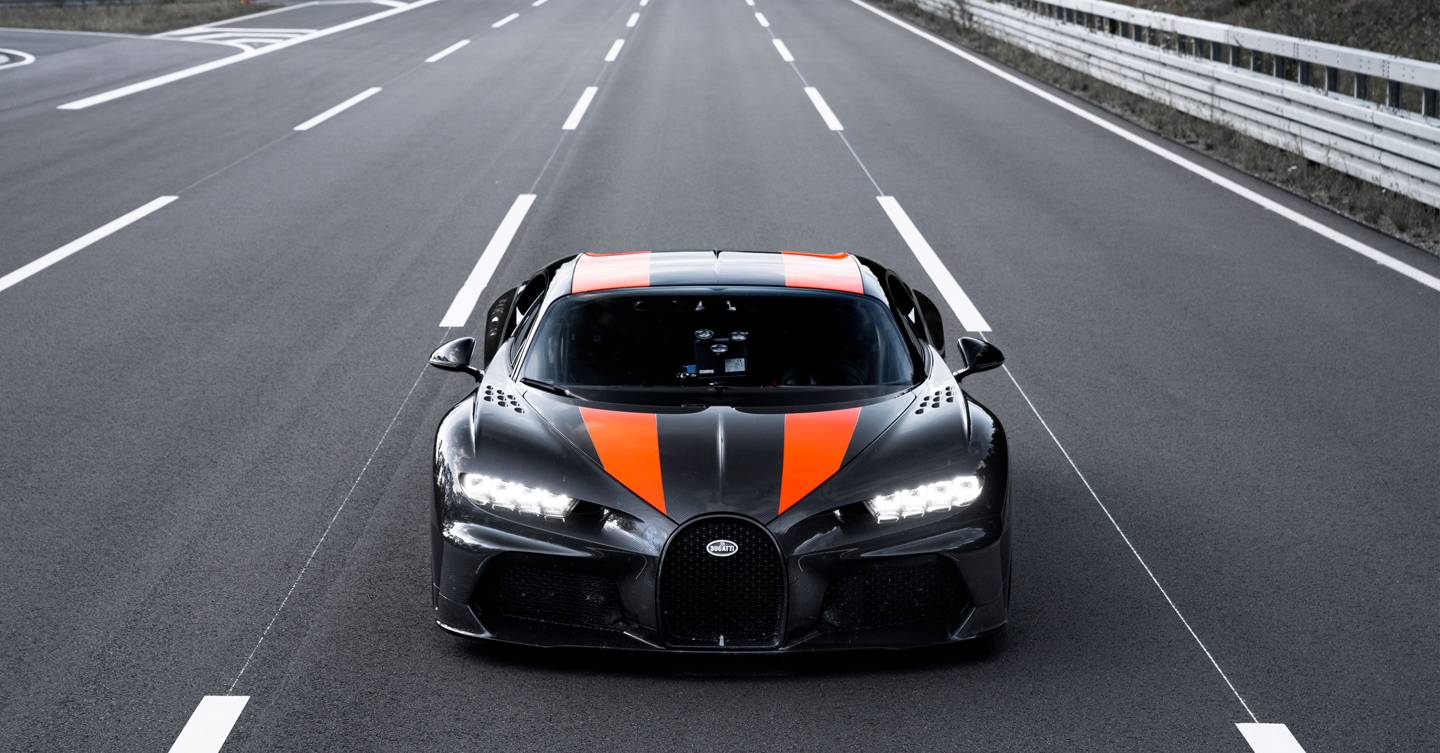

The race for straight-line pace is as old as the automobile itself. Henry Ford, often cited as the man who delivered cars to the masses, attempted to get as close to 100mph as he could aboard his Arrow back in 1904.
Ford managed 91.37mph, but history states he attempted the record on a frozen Lake St Clair, near Detroit, Michigan and subsequently scared himself stiff. Fast-forward to 1949 and a production model Jaguar XK120 majestically wafted to 124.6mph before a German-built Mercedes-Benz 300SL retaliated in 1955, reaching 152.2mph. You can see where this is heading.
But since the advent of the modern supercar, manufacturers have been coming up with ways to best the competition and what better way than with a retina-stinging top speed? Now Bugatti’s Chiron has passed the 300mph for the first time, hitting a top speed of 304.77mph.
Copious amounts of horsepower is the obvious method to win, but Bugatti was the first manufacturer to prove that it is possible to go extremely fast in the lap of luxury (and safety) when its Veyron hit 253.81mph in 2005. Here was a car that could happily cruise London’s King’s Road before effortlessly hitting over 220mph at the hands of a relative novice.
After a series of top-speed attacks from rival manufacturers, Bugatti returned in 2010 with a Super Sport model capable of 258mph. But in an age where technology seems to be advancing by the second, why has it taken until now for a manufacturer to reach the coveted 300mph mark?
“The differences between a 200mph and a 300mph car are huge,” says Kia Cammaerts, founder of Ansible Motion, creators of cutting edge Driver-in-the-loop simulators for motor sports teams. “The aero drag created is more than twice as much, and the jump from 260mph to 300mph sees that figure at 1.3 times as much. The engine has to supply the grunt to overcome this force, so it must be greatly increased in terms of performance, and in approximately the same space package there will be much more heat to get rid of.
“Also at these speeds, aero forces are much harder to control and change more quickly – even a super slippery shape will need downforce to control it and the centre of pressure must be maintained in the right place,” he adds.
Power hungry
Power is clearly the first element required to achieve these wild top speeds, and the Chiron’s 8.0-litre, quad-turbo W16 unit, nicknamed ‘Thor’, now develops some 1,578bhp – a staggering 591 additional horses when compared to the Veyron that arguably kick-started this game of one-upmanship.
Competitors cottoned on to the fact that adding power aids greater top speeds ever since Bugatti first laid down the gauntlet, with the likes of SSC’s Ultimate Aero TT, which took the Veyron’s crown in 2007, and the 277.87mph Koenigsegg Agera RS both boasting well in excess of 1,000bhp.
However, calculating the desired output figure is a complicated equation that includes air density, rolling resistance of the tyres, resistance created by downforce and the power naturally lost through the drivetrain. With great power comes great responsibility, and under these circumstances, engineers are forced to install sufficient cooling to ensure the engine doesn’t burst into flames. Additional cooling means extra weight and, more importantly, extra vents, ports and inlets that create more drag that in turn slow the car down.
To create the downforce and stability required to prevent the car from taking off, Bugatti teamed up with Italian race specialist Dallara to fashion a bespoke aerodynamic kit in order to achieve what is known in the industry as ‘neutral downforce’.
Speaking to Autocar [https://www.autocar.co.uk/car-news/new-cars/bugatti-chiron-goes-304mph-set-hypercar-record] after the world-record run, driver Andy Wallace said: “Net zero downforce front and rear sounds easy, as you’ve got the static weight of the car pushing down and that’s more than heavy enough.
“But it doesn’t mean the air is having no effect, there’s close to 2,000kg on the top surface of the body trying to pick the car off the ground and another 2,000kg under the car trying to pull it back down – two fighting forces that come to four tonnes. So you’ve got to be absolutely sure that everything on the car is secure enough to go this fast.”
The shape of speed
The special Chiron is 25cm longer than the car upon which it is based, while a much lower ride height has been introduced to ensure the lowest possible drag efficiency. Even the Chiron’s active rear air brake has been removed and replaced with a much smaller static version that is artfully integrated into the tail section.
After many hours of CFD modelling, Bugatti completely overhauled the exhaust pipes and replaced the standard units with a set of stacked ‘shotgun’ pipes, which were first seen on the recent £9 million Centodieci vehicle. This exhaust system projects waste gasses further away from the rear of the vehicle and prevents this dirty air from affecting the aero and drag.
The choice of test facility is also essential in this quest for speed, with the Ehra-Lessien high-speed track in Lower Saxony boasting 21km (approximately 13 miles) of smooth and gently curved three-lane highway to complete the task.
In order to do so, Andy Wallace accelerated out of the north curve to 200km/h (124mph) to reach top speed on the 8.8km straight that followed. But the circuit is not without its faults, as its position 50 metres above sea level means it suffers from a much higher air density than fellow facilities stationed at altitude.
“Air pressure, air density and temperature are very important for high-speed driving and can make a difference of up to 25km/h, depending on the altitude,” says Stefan Ellrott, Bugatti’s head of development. “A world-record attempt at such an extreme speed of over 400km/h always involves a certain risk. Everything has to be right – the car, the weather and the track. Ehra-Lessien offers the greatest possible safety, which is why we opted for this track,” he adds.
To make sure absolutely nothing stood in the way of the Chiron and the 300mph mark, the carriageway at Ehra-Lessien was cleaned with special mats prior the road test in order to pick up stones and grit.
Burning rubber
“Tyres are critical to any attempt at this speed,” explains Adam Donfrancesco, lead engineer at CALLUM, who is behind a number of high-performance road and race car programmes. “They need to withstand intensive loads through the sidewalls and the temperatures, both of the carcass and air temperature inside the tyre. Even the tyre pressure monitoring sensor, a small device that weighs probably 30g can weigh, via centripetal forces, in effect over 80kg,” he adds.
Michelin has long been one of Bugatti’s developmental partners and the high-speed tyres created especially for the Chiron were again reinforced, particularly the belts, to handle the 5,300G. After all, the tyres rotate up to 4,100 times in one minute. Amazingly, they remain street legal.
According to Bugatti’s head of development, the tyres were subjected to extensive test-bench trials at speeds of up to 511km/h in the USA, then each tyre was X-rayed to show up to the smallest details.
“The suspension must cope with much more energy from the ground – not only will bumps arrive quicker at the higher speed, but gentle waves in the road surface will be compressed into bumps that have to be handled. The entire chassis will have to be developed to cope with such forces,” explains Kia Cammaerts.
“To take a hypercar performance like the Veyron Super Sport and add 40mph to it is a phenomenal piece of multi-disciplinary engineering,” he adds. However, Stephan Winkelmann, president of Bugatti, exclaimed that after setting the new TÜV-certified speed record of 304.773 mph, the Volkswagen Group-owned marque would no longer be chasing top-speed records.
Instead, Bugatti will focus on the traditional attributes that make its cars special, chiefly “exclusivity, luxury, unmatched beauty and a high level of automotive craftsmanship”, Winkelmann says.
We would bet good money that it won’t be long before a rival manufacturer attempts to steal the crown, with US-based Hennessey claiming its Venom F5 develops over 1,600bhp from twin-turbo 8-litre V8 engine, making it capable of a claimed 301mph. Don’t be surprised if Bugatti dusts off its Super Sport badge one more time, as history has proven that the auto industry just can’t curb its addiction to speed.
More great stories from WIRED
🍔 World-class chef rates the best vegan burgers in the UK
😡 TikTok is fuelling India’s deadly hate speech epidemic
🍫 The foods you’ll really need to stockpile for no-deal Brexit
♻️ The truth behind the UK’s biggest recycling myths
🤷🏼 How is the internet still obsessed with Myers-Briggs?
read more at https://www.wired.co.uk/ by Leon Poultney
Tech








